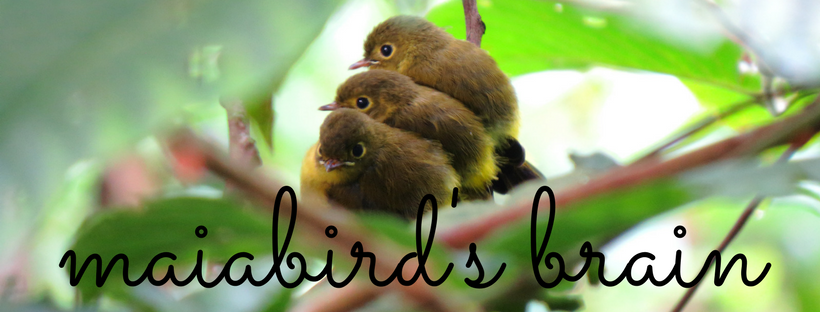 |
| We brake for waders!!! |
We saw Black-winged Stilts, Long-toed Stints, Whiskered Terns, and Wood Sandpipers in a small patch of mud. The surrounding paddies, and those on the other side of the road, were already planted on. It was a good time to review and refresh wader identification! Out came the field guides!
 |
| Thank you again, Jun for the Shorebirds field guide! =) |
We were able to talk to some of the people on the side of the road and they told us of the birds they would see. One of them mentioned a black egret they've been seeing, "May itim na tagak na dumating... doon" and my heart skipped a beat at the possibility of a Glossy Ibis in Candaba! I asked if it was smaller than the white egrets and he said they were the same size. I asked if the beak was curved downwards and he gave me a funny look and insisted it looked like the regular white egrets. So much for an ibis =P
We drove further down the concrete road and were saddened to see the place overgrown with plants. No waders or ducks in sight! We did see the usual Candaba birds: large flocks of Red Turtle Doves, Yellow Bitterns, Pied Bushchats, White-browed Crakes, and... we saw exactly what the man was describing earlier: a black egret!
 |
| Yellow Bittern |
The lone all-black bird was flying high above the fields. It was definitely not a Black Bittern, which usually doesn't fly that high and it lacked the streaking on a Black Bittern's throat. Could it be an Eastern Reef Egret? Why was it inland? Soon the black egret flew away, out of sight.
We inspected a nearby pond which contained some ducks the last migration season. It was empty save for a Little Grebe and another Yellow Bittern.
 |
| Overgrown much? |
We decided to check out the ex-mayor's property. Along the way, we would ask people about the road conditions and we got varying answers about the softness/muddiness of the road. We did get a consistent answer: we'd definitely get stuck if we bring the car.
While talking to some people, we got distracted by a flock of soaring birds. We got very very excited as the birds looked new to all of us. We spent time observing them though our binoculars, taking photos, and listing field notes. We thought we got a lifer! But it turned out, the birds were Oriental Pratincoles taking flight to hunt for food. Not lifers for me, but lifers for Willem and Juan =)
 |
| Oriental Pratincole in flight |
Seeing the Pratincoles soaring so high was new behavior to me. I've always seen Oriental Pratincoles just standing still or flying low over the fields, that the behavior I saw didn't make me think of them initially.
We were approached by Say-say, a young lady we asked about the road condition. She offered to take us into the property on her tricycle. We all agreed to brave the heat, roads, and transportation choice. We parked the Fortuner in Say-say's property along the road, boarded the trike and were off the muddy, bumpy road.
 |
| On board our stainless steel trike with Say-say driving |
 |
| At some points, we had to get off and walk so the trike could get though the deep muddy portions of the road |
The rice paddies along the road were all overgrown and we didn't see any birds there. =( When we reached the big pond, we were surprised to see a backhoe! Say-say told us they were building a path that would cut across the big pond so people could get across faster. The pond, which used to have ducks and also house a big rookery of Purple Herons, was also overgrown. No ducks and the Purple Herons were "pushed" to the right side of the pond. Too much disturbance, too little water... Where will the birds go??
 |
| The backhoe did serve as a good "watchtower" |
We were able to spot some Pheasant-tailed Jacanas among the vegetation, which was a lifer for Willem. There were still a few Black-crowned Night Herons but zero ducks, swamphens, and crakes. We decided to walk away from the ex-mayor's house towards the back pond which used to hold a lot of ducks.
We stopped by the adjacent pond and saw more jacanas flying around and some Common Moorhens. On the other pond, we saw a total of three Wandering Whistling Ducks. AND! We also did see another black egret flying in and across the pond. Hmmm...
Our last stop was another pond were we usually see Tufted Ducks and Eurasian Coots. No Tufteds and no Coots but we did see four Philippine Ducks. Four. Only four. And they soon flew away. =(
 |
| The only four Philippine Ducks we saw that morning. |
We decided to head back and call it a day. It was still good birding but it was noticeably a different Candaba we birded in. Aside from it being my first time to ride a trike there, it was also my first time to see a black egret that was possibly not an Eastern Reef Egret! Also, sadly, the landscape has changed so much. I wouldn't be surprised if the birds decide to look elsewhere to stop during their migration. It definitely wasn't the same Candaba we frequented in the past...

























